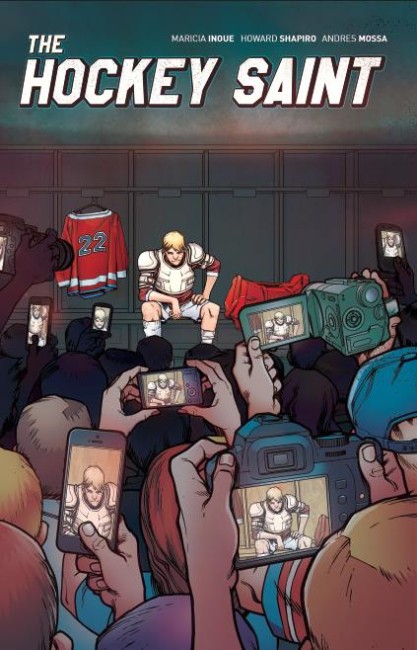Written by Howard Shapiro, “The Hockey Saint” might not be your typical hockey book, but it sure one that could be gobbled up by readers of all ages. Being a graphic novel, “The Hockey Saint” offers readers a chance to sit back and relax while enjoying some leisurely reading that carries a number of messages through its words and illustrations.
Following the path of its protagonist, Tom Leonard, “The Hockey Saint” poses a scenario in which a college athlete meets a world-class hockey player by the name of Jeremiah Jacobson. Attaining superstar status through his phenomenal play, Jacobson isn’t portrayed as a media darling because of his friendly relations with media outlets, but as an individual that is revered for his talent on the ice. Regardless of his on-ice talent, Jacobson finds himself the target of a potential smear campaign – one that not only threatens his livelihood as a hockey player, but one that could seriously interfere with his personal life.
Media Good Guys?

Throughout Shapiro’s graphic novel, one can see the battle that Jacobson has with the media and speaking to traditional outlets. Instead of being open to all forms of media, Jacobson picks and chooses the media outlets that he wants to speak to – usually shunning traditional forms and not giving answers that would simply please the team’s PR staff.
While fans, members of the media, and team personnel of any given team might not understand why a certain player is unwilling to make themselves available for interview, “The Hockey Saint” attempts to give its readers a glance at why some individuals could be so opposed to wanting to be in the public eye. Of course, it’s easy to think that if an athlete makes millions of dollars, then the least that they can do is to be open to those that want to get a closer look into their lives.
However, in today’s day and age of media availability, a person’s privacy – especially that of elite level athletes – or their quality of life could certainly be affected by media irresponsibility. Despite having mixed feelings toward an athlete’s selectivity of media sources, the scenarios definitely made sense when presented by Shapiro.
Although Jacobson conducts interviews with school newspapers, blogs, and other outlets that have little to nothing to do with sports, the superstar CAHL player is for all intents and purposes a recluse who would much rather be mum in regard to both his on-ice and off-ice life. Not wanting his family and friends to be hurt by whatever image fans or media could make of his off-ice life, Jacobson’s mistrust of sports media goes to relatively great extents as he does everything in his power to conceal certain aspects of his life, such as his marriage.
By not being available to sports-related media, Jacobson leaves himself open to being portrayed as anything that the media views him as, and his altruistic off-ice exploits – which he doesn’t want others to know about – go largely unnoticed. Actively excluding certain people from gaining a glimpse into his life, Jacobson successfully avoids sharing the positive aspects of his life with anyone – aside from his wife and Tom Leonard – but his indulgence in certain vices is also protected by his reclusiveness.
The Moral Message
Having all of the athletic ability in the world doesn’t necessarily mean that an individual isn’t susceptible to the things that tempt human beings every day. With various beer, liquor, and cigarette commercials and advertisements populating today’s world, it could be very easy for an individual to lose oneself in dangerous addictions.
Such is the story shown to us by Shapiro when it comes to depicting Jeremiah Jacobson. Sure, Jacobson is a supreme talent whose skills are lauded by a vast majority of people, but his human side is shown as Shapiro shapes Tom Leonard’s character during the latter stages of the graphic novel.
Despite taking time off and endangering his status as a college hockey player and student, Leonard does not fail to see that his newfound friend’s life could easily spiral into oblivion if his addiction is not treated. Taking a path that Leonard knows could jeopardize his friendship with Jacobson, the protagonist ultimately trusts his morals and instincts when he pushes the superstar to become a better and more responsible individual.
The Overarching Message
While many might not necessarily want to hear this, Shapiro’s development of Jacobson essentially shows that athletes – regardless of how driven or gifted they are – are human beings as well, and ones that can be just as flawed as the next person.
At the end of the graphic novel, readers are exposed to Jacobson’s flaws as he admits to his vices and describes just why he has sheltered himself from some forms of media. What makes the overarching theme of this book even more interesting is the fact that Jacobson never makes it perfectly clear if he’s interested in going through rehab for his problems – something that just reinforces the notion that athletes also deal with the same struggles as everyday people.
As fans of one of the greatest sports, we are privileged to see some of the best athletes perform on a frozen stage with little to no regard for their personal well being. Sometimes it’s hard to not root for these warriors, and sometimes it’s even harder to not be able to learn more about one’s favorite forward, defenseman, or goalie. While the lives of athletes are oft-followed through various forms of media by a wide range of people, “The Hockey Saint” thoroughly illustrates – even through a fictional plot and narrative – that athletes can have lives that are just as complicated as our own and ones that they are not comfortable with disclosing to the general public.